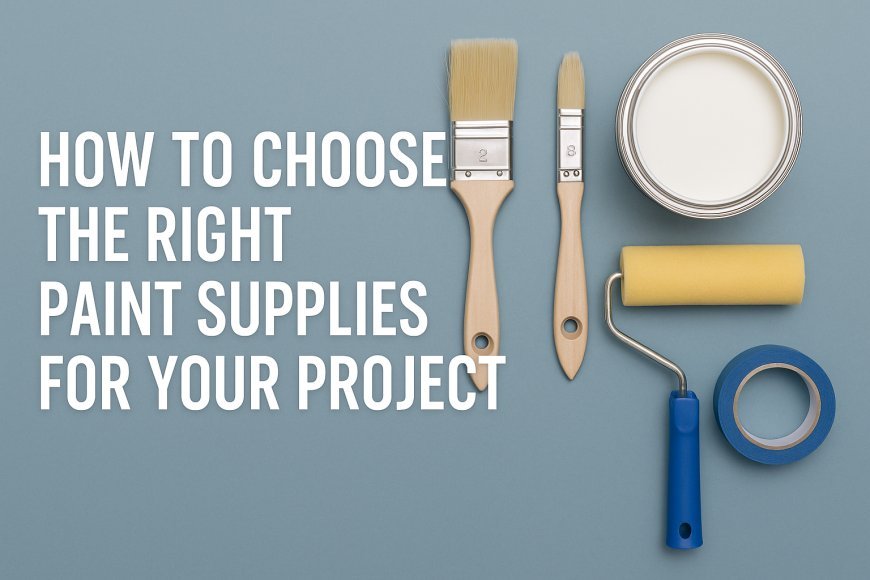How to Choose the Right Paint Supplies for Your Project

If you have to repaint your living room, paint your office, or redo a piece of furniture, the secret to a high-quality finish is choosing the right paint supplies. There are numerous products to choose from, and it can be difficult to determine which materials and tools to use. In this tutorial, we will demonstrate how to pick the right paint supplies for your project and achieve excellent results with little effort.
Why Selecting Proper Paint Materials is Important
Most individuals prefer to think only of the paint color when starting a project, but the quality of your materials can actually make or break it. Using the wrong brushes, rollers, tapes, and primers can make the paint apply unevenly, adhere poorly, and wear off faster. Cheap materials can cause mottling, streaks, and drips of paint, making your project look substandard.
1. Identify the Surface Type
Prior to purchasing paint materials, inspect the surface you are going to paint. Is it wood, metal, concrete, or drywall? All surfaces require different preparation materials and supplies.
-
Drywall: Utilize water-based paints and medium-nap rollers.
-
Wood: Smooth out the surface with sandpaper, prime the wood, and brush or roll paint.
-
Metal: Use a primer that stops rust and a synthetic bristle brush for accuracy.
-
Concrete: Select masonry paint and apply using tough rollers or sprays of paint.
Matching your material to the surface ensures proper coverage and durability.
2. Choose the Correct Paint Type
The kind of paint that you're using—latex, acrylic, or oil paint—will determine what sort of brush or roller to use:
-
Latex Paint: Suitable for interior walls; simple to clean and dries fast with water.
-
Oil-Based Paint: Provides a hard, shiny finish; works best on trim and cabinets.
-
Acrylic Paint: Great for application on exterior surfaces; highly weather-resistant.
Always refer to the paint label for advice on appropriate applicators.
3. Select the Right Brushes and Rollers
Using the correct brush or roller is very critical in achieving a clean, streak-free finish. Here is how to choose one:
Paint Brushes:
-
Angled Brush: Ideal for painting edges and small details.
-
Flat Brush: Most appropriate for large flat areas such as cabinets and doors.
-
Natural Bristle: Best suited for oil-based paints.
-
Synthetic bristle (nylon/polyester) is water and latex compatible.
Paint Rollers:
-
Short Nap ”(1/4”–3/8”): Good for smooth surfaces like drywall or plaster.
-
Medium Nap" (3/8"–1/2"): Gently rough walls or ceilings.
-
Long Nap (3/4"–1"): Coarse surfaces like brick or stucco.
Purchasing quality rollers reduces splatter and allows for even coating.
4. Don't Miss the Primer
Primer is required for surface preparation, especially if you're painting over dark or if you're using raw materials like wood or metal. It will make the paint stick better and achieve an even-looking finish.
-
Stain-Blocking Primer: Apply where covering water or smoke stains.
-
Bonding Primer: Applied on smooth or difficult-to-paint surfaces.
-
Multi-Surface Primer: A general-purpose choice for all uses.
5. Make Straight Lines Using Painter's Tape
Painter's tape protects baseboards, trims, and edges. Select tape according to surface and time:
-
Blue Tape: Ideal for walls, molding, and ceilings; easy removal after 14 days.
-
Green Tape: More aggressive adhesive for exterior or rough surfaces.
-
Low-Tack Tape: Ideal for delicate surfaces such as fresh paint or wallpaper.
Straighten the tape and press firmly down to stop the bleed-through.
6. Other Basic Paint Tools
These are a few more things that will simplify your project and your outcomes:
-
Drop cloths or plastic sheets: protect cover floors and furniture.
-
Paint Trays: Store paint for roller application.
-
Extension Poles: Make ceiling and high-wall work easier.
-
Stirrers and Pour Spouts: Offer uniform consistency and mess-free application.
-
Sandpaper or Sanding Sponge: Sand out rough surfaces prior to painting.
7. Safety First
Don't lose sight of wearing protective gear. Ensure that you work in ventilated spaces and wear masks when sanding or handling oil-based paint. Gloves and goggles will shield your skin and eyes from splashes.
Final Thoughts
Selecting the proper materials to paint with is just as crucial as selecting the proper color. Taking the time to locate the proper materials and equipment to suit your project requirements will help you steer clear of common painting problems and achieve a professional finish.
Whether you're tackling a small do-it-yourself project or a full-scale home renovation, investing in quality paint products will pay off in the long run with the time, effort, and money you save. Ready to begin? Use this guide to make your supply list and shop smart for a cleaner, better finish.
What's Your Reaction?




























































